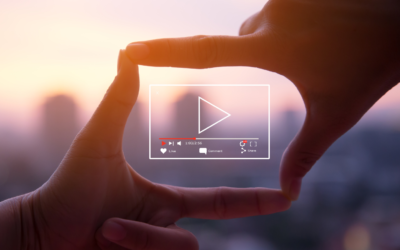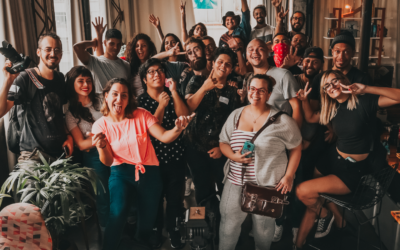This post was originally published as a 3 part series on the PBS Station Products & Innovation blog by Slavik Boyechko. The Station Products & Innovation Team collaborates with stations in the development of products and services that enable stations to better engage with their audience. To access the original article, click here, here & here.
When the DSLR revolution hit a few years ago, the world of cinema-like videos was finally accessible to the masses, and with it came a massive DSLR gear industry. Thousands of blog posts, product reviews, and unboxing videos later…the beginning filmmaker now faces the daunting task of “what to get?”
So while I thoroughly recommend spending all your evenings and weekends dedicating your life to reading gear reviews, here is an essential summary of the DSLR essentials…so your station can fast-forward to the actual point of all this, making cinematic videos!
Camera Body
Canon was the first, and continues to be the go-to choice for DSLR filmmaking, due to a third-party firmware “hack” called Magic Lantern. I recommend the 60D because:
- Its recent updated version, the 70D, still doesn’t have Magic Lantern
- Its swivel LCD screen is essential for low and high shots, which is not an option in the 5D Mark II and III or the 7D
- The lower-end Rebel cameras have short battery lives and clunky ISO, aperture, and White Balance adjustments
- You can actually monitor audio with your headphones, with this cable.
Lenses
Like many beginning filmmakers, we started with fixed prime lenses because they were affordable and were low-light sensitive.
But once we could afford them, we’ve saved ourselves many headaches with lens changes and shaky video by moving to Image Stabilized (“IS”) zoom lenses.
- Canon 17-55mm f/8 IS is on our cameras 90% of the time for Indie Alaska videos.
- Canon 70-200mm f/2.8 IS is what we use for our interviews and telephoto. It’s expensive and heavy, so if your budget doesn’t allow for it, you can sacrifice some low-light sensitivity by going for the Canon 70-200mm f/4 IS.
- Tokina 11-16mm f/2.8 for wide angle, walking shots, in car, small space, slider shots, steadicam, and generally cool wide shots.
- As an alternative, the Canon 24-105 f/4 IS can serve as one all-around lens for just about any shot, as well as interviews. But it’s not ideal in low light, unless you move into the higher-end DSLRs (like the 5D or new Canon Cinema cameras) which can record high ISO video without much noise.
- We also have a couple Canon 24-70mm f/2.8 non-IS lenses that are great for interviews locked down on tripods, but lack of IS keeps it out of our bag anytime we go out to shoot in the field.
- Because it’s small and relatively cheap, I recommend keeping a Canon 50mm f/1.4 (or the super cheap f/1.8) in your bag anytime you have really low light or want that razor thin cinematic depth-of-field effect.
Audio
The camera’s internal mic is not good. So you’ll want a shotgun mic for B-roll, and a LAV for interviews and on-camera subjects or hosts. With the Canon 60D, you can monitor and record audio directly into the camera, or use a separate audio recorder for better quality.
- Rode VideoMic Pro – get this and keep it on your camera at all times, except when you’ve got a LAV recording to the camera.
- Sennheiser G3 Wireless Lav – it’s expensive but worth it. You’ll need a set of two for an interview.
- Sony ECM-44 Wired Lav – we use this wired mic for interviews, rather than the Sennheiser wireless mic, whenever we have our Tascam 60D audio recorder attached. If your station already has some Marantz recorders, you may not need the Tascam, but it’s convenient in that it attaches to the back of the camera when the 70-200 is attached to the tripod.
- Are there other audio options? Yes, preamps, different audio recorders, boom mics, and Lavs that record to iPhones (for syncing in post)…but the above setup is simple and dependable.
Rigs
If you really want to look cool, there are some crazy-looking shoulder rigs (with names like “Enforcer” and “Marauder”), with matte boxes, follow focuses, rails, several handles (in case you have 4 hands). But after trying a bunch of them out, we’ve settled on the simplest, most functional shoulder support.
- Opteka CXS-1 Shoulder Rig is what we use, with a counterweight that we’ve attached via a door hinge for optimum shoulder hugging. There are other versions out there, like one by Revo and by Habbycam.
- Believe it or not, the $30 CowboyStudio shoulder rig is pretty good. You won’t look as cool as you would with an “Enforcer,” but it works.
Tripod/Monopod
The tripod you choose is not as important as the video fluid head, but if you don’t have any at your station yet, the Manfrotto 055XPROB is affordable and good for traveling, as is the Sachler Ace M. We use both. The Manfrotto will need a camera leveler like the Manfrotto 438. You can also go with some of the expensive (but light weight) carbon versions of popular tripods. There are many.
- The Manfrotto 561BHDV-1 monopod is a staple among DSLR filmmakers. Some use it exclusively instead of a shoulder rig.
- There are lots of fluid heads out there. The nice thing about the Sachler Ace is it comes with one. For our other cameras we went with the budget filmmaker favorite – the 717AH from various Chinese manufacturers. It’s smooth but only allows slow movement. Manfrotto makes the 500AH now that’s pretty affordable.
Slider / Steadicam
- One of the quintessential cinema-like shots is the dolly or slide shot. It’s awesome as a bonus shot for docs, and essential for any slick TV spot or underwriter credit. We have a Konova slider, but I also recently got the Cinevate Duzi, which is smaller but really lightweight and portable. Kessler also makes great sliders.
- It will kill your wrist for a few days, but a steadicam like the Glidecam HD 2000 is really cool for walking shots. Use your Tokina 11-16mm and set it to as high an F-stop as possible, because you won’t be able to shift focus while handling this thing.
MISC.
- You’ll need a Variable ND filter to block light for outdoor shooting, so you can still preserve cinematic depth of field. Get the 77mm and step-up filters for any lenses that have a smaller filter diameter.
- Get a handful of Manfrotto 394 Quick Release Plates and put them on your rig, tripod, slider, steadicam, and camera.
- Extra Canon 60D batteries, several 32gb SD cards, a lens microfiber wipe, XLR cable for the wired Lav mic, stereo cable for the Tascam-to-Camera connection, lens hood for theCanon 17-55mm (it doesn’t come with one, for some reason), UV filters for your lenses, and moleskin to hide the Lav mic under people’s shirts (you can get this at any pharmacy, just cut up into 1-inch squares).
- Hopefully your station already has some indestructible Portabrace bags. If not, there are lots of bags out there. You’ll want a long one for your tripod, monopod, and light stands.
- If you don’t dig the LCD screen on the 60D (and focus peaking with Magic Lantern), many DSLR filmmakers trust their life with a Zacuto Z-finder viewfinder, which magnifies the screen and serves as another contact point for camera stability. On occasion we actually shoot purely handheld (no shoulder rig), with the z-finder.
- Don’t get caught up in the external monitor thing. It’s nice for narrative filmmaking, locked on tripods, with multiple people reviewing the footage…but is way too cumbersome for run and gun documentary shooting, in my opinion.
- If you want your host to read a script, you can use an iPad teleprompter controlled by an iPhone or iPod Touch. We still use our cheap $99 teleprompters from ebay, but they can be a bit unruly and unstable in the field, so I’d recommend the PadPrompter. We use the Teleprompt+ app.
Editing
I think the most important part of our DSLR kit is actually not in the camera bag at all. It’s a 15″ Macbook Pro Retina (with 16GB ram), editing off a 2TB Western Digital Passport USB3 drive, with an Apple Magic Mouse, all edited on Final Cut Pro X. It will change your life.
And that’s it! Do you need all of this to get started? No. Often we shoot with just a handful of this gear. But this list is the product of several years of pairing down our kit to the bare essentials. But again, I recommend you quit your hobbies and dedicate all your free time to browsing DSLR blogs and forums for gear reviews and how-to’s…because hey, it’s fun, and guess what, you’re a filmmaker now, so go out and join the filmmaking community.
Get more documentary film news and features: Subscribe to POV’s documentary blog, like POV on Facebook or follow us on Twitter @povdocs!
This article is courtesy of: http://www.pbs.org/pov/blog/2014/01/create-your-own-essential-dslr-video-kit/#.VKrEuFobBuV
The Audience Awards is film’s social network connecting audiences to films, filmmakers, film schools and film festivals. The Audience Awards hosts short film competitions where the audience chooses the best films.







